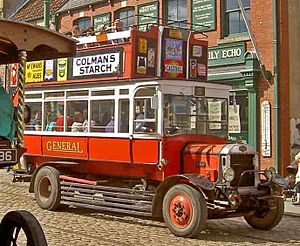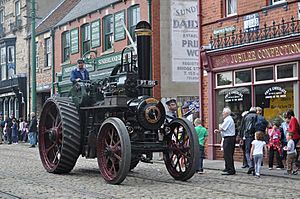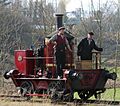Beamish Museum transport collection facts for kids
Beamish Museum is a fantastic open-air museum in the North East of England. It shows what life was like in the region during the 1820s, 1900s, and 1940s. Because the museum is so big, it needs good ways to move visitors and staff around. This means transport is a really important part of the Beamish experience! You can see and even ride on many different types of old vehicles here.
Contents
Trains and Railways at Beamish
Beamish Museum has a great collection of old trains and railway wagons. These are used to show how people and goods moved around in the past.
Standard Gauge Locomotives
Standard gauge railways are the most common type of railway track. At Beamish, you can see various wagons on display in the railway station yard. For a long time, steam trains didn't run regularly here. However, some locomotives from nearby railways have visited. The museum's old North Eastern Railway coach returned to Beamish in 2012 to be fixed up and used.
One of the museum's own locomotives is No. 876, a freight engine built in 1889. It was moved away for a big restoration project in 2007. Another engine, No. 14, used to run until 1994.
In 2011, the museum borrowed a 1923 LNER Y7 Class engine. This engine carried passengers at Rowley Station on weekends during the summer. Another locomotive, Dunrobin, was bought by Beamish in 2010 and is being restored. In 2012, Beamish also bought a saddle tank engine called Newcastle, which is also planned for restoration. The museum often hires other steam engines to run trains on weekends and school holidays. For example, John Howe visited in 2014, Portbury in 2015, and Bon Accord and May were used more recently.
Waggonway Locomotives and Stock
The Pockerley Waggonway at Beamish has special replica steam locomotives. These are copies of very early steam engines. The museum has three famous replicas: Locomotion No. 1, Steam Elephant, and Puffing Billy. Usually, one of these is running each day. An original 1850s locomotive, Hetton Lyon, used to be on display.
| Name | Wheel arrangement | Original build date | Replica build date | Original builder | Original operator | Current status | Image |
|---|---|---|---|---|---|---|---|
| Puffing Billy | 0-4-0 | 1813 | 2006 | William Hedley | Wylam Colliery | Operational | 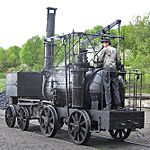 |
| Steam Elephant | 0-6-0 | 1814 | 2002 | William Chapman | Wallsend Colliery | Stored, Awaiting overhaul | 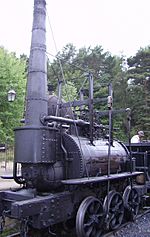 |
| Locomotion No. 1 | 0-4-0 | 1825 | 1975 | George Stephenson | Stockton and Darlington Railway | Awaiting overhaul & Static Display National Railway Museum Shildon | 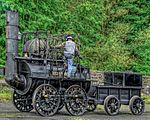 |
| Hetton Lyon | 0-4-0 | 1851 | N/A | Young | Hetton colliery railway | Static Display, National Railway Museum Shildon | 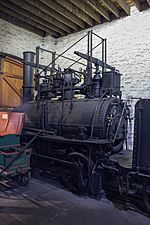 |
Puffing Billy Replica
Beamish has a copy of Puffing Billy, built in 2006. The original Puffing Billy was built in 1813/14. It is the world's oldest surviving steam locomotive! It was designed to pull coal wagons at Wylam Colliery. The name might come from its owner, who had a breathing problem that made him sound like the engine. It was special because it was the first steam train that moved by simply gripping the rails with its wheels.
The original engine was very heavy and broke the tracks. So, it was rebuilt with more wheels to spread its weight. Later, when stronger tracks were made, it went back to its original design. Puffing Billy worked until 1862 and is now in the Science Museum in London.
Steam Elephant Replica
The museum's replica of Steam Elephant was built in 2001. The original locomotive was built in 1814/14. For a long time, people didn't even know it existed! It was used at Wallsend Colliery and later at other collieries. The replica was built using old paintings as a guide.
Locomotion No. 1 Replica
Locomotion No. 1 is a copy of an engine designed by George Stephenson in 1825. This original train was the first steam locomotive to carry passengers on a public railway line! The Beamish replica was finished in 1975 for the 150th anniversary of that railway. The original Locomotion No. 1 is now on display at the National Railway Museum Shildon. The Beamish replica is currently waiting for repairs.
Hetton Lyon
Hetton Lyon was built around 1851/52 for the Hetton colliery railway. It was an older design for its time. It survived by being used as a stationary engine for a sawmill. Later, it was put back into service for celebrations in 1925. It has been loaned to Beamish twice and is now back at the National Railway Museum Shildon.
Waggonway Carriages
The carriages used on the waggonway are copies of early designs. One is like the "Experiment" carriage used on the opening day of the Stockton & Darlington Railway. There is also an open carriage from a slightly later time.
Carriages and Wagons
Beamish also has a collection of railway carriages and wagons. These include replicas and original vehicles from different railway companies. For example, there's a replica of a Stockton & Darlington semi-open carriage built in 1995. There's also an old North London Railway carriage that was used by workmen. A Highland Railway saloon carriage, built in 1909, ran with the Dunrobin locomotive. One of the oldest railway carriages on its original frame, a Stockton & Darlington four-wheel third class carriage, is currently being restored at Beamish.
Trams at Beamish
Beamish is home to several electric trams. Some of these run every day, giving visitors a ride around the museum. There is also a horse-drawn tram in the collection.
Tram Collection
| Original operator | Number | Year built | Current livery | Seats | Current status | Image |
|---|---|---|---|---|---|---|
| Sunderland Corporation Tramways | 16 | 1900 | Crimson and cream | 66 | Operational | 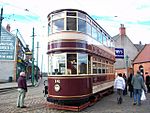 |
| Grimsby & Immingham Electric Railway | 26 | 1925 | British Railways green. | 48 | Undergoing overhaul | 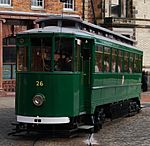 |
| Blackpool tramway | 31 | 1901 | Red, white and teak | 86 | Operational | 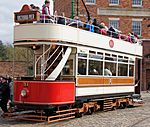 |
| Newcastle and Gosforth Tramways and Carriage Company | 49 | 1880 | N/A | N/A | Undergoing restoration | |
| Gateshead and District Tramways Company | 51 | 1900 | N/A | 32 | Awaiting restoration | |
| Gateshead and District Tramways Company | 52 | 1901 | N/A | 32 | Awaiting restoration | |
| Oporto Tramways Company | 65 | 1933 | Chevrons | 0 | Undergoing restoration | |
| Newcastle Corporation Tramways | 114 | 1901 | Brown, yellow and white | 53 | Operational | 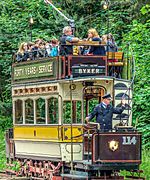 |
| Oporto Tramways Company | 196 | 1935 | Blue and primrose yellow | 28 | Operational | 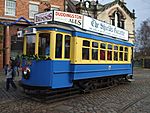 |
| Sheffield Tramway | 264 | 1907 | Blue and cream | 54 | Operational | 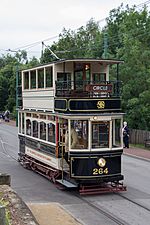 |
| Sheffield Tramway | 513 | 1950 | Blue and cream | 62 | Operational, on loan to the East Anglia Transport Museum |  |
Gateshead 10 (Grimsby 26)
Gateshead 10 was built in 1925. It was a single-deck tram used in Gateshead and Newcastle. When the Gateshead tram system closed in 1952, this tram was sold to British Railways. It then worked on the Grimsby & Immingham Electric Railway as No. 26 until 1961. Instead of being scrapped, it was saved for preservation.
The museum bought the tram in 1968 and restored it to its Gateshead 10 look. It was the first tram to arrive at Beamish and was used for the first passenger rides in 1973. It had a big rebuild between 1983 and 1985. In 2012, it was repainted to look like its Grimsby days. It is currently undergoing another overhaul and will return as Gateshead 10.
Sunderland 16
Sunderland 16 was built in 1900. It was an open-top double-decker tram. It is the only original Sunderland tram that still exists. After World War One, its open top was changed to a closed deck. It also had other changes over the years. When the Sunderland tram system closed in 1954, this tram was saved. Its lower part was used as a tool shed on a farm.
The museum rescued the tram body in 1989. They rebuilt it to look like it did in the 1920s, with a new upper deck. The restored tram started running in 2003. After another overhaul, it returned to service in 2014.
Blackpool 31
Blackpool 31 was built in 1901 as an open-top double-decker. It was rebuilt in 1918 with a longer body. In 1928, a top cover was added. In 1934, it became an engineering tram, used for maintenance, and was renumbered 4, then 754.
It was loaned to Beamish in 1984. The museum restored it to its 1920s open-top look. It started running in 1988, mainly in the summer. It went back to Blackpool for a short time in 1998 for celebrations. The tram was taken out of service for an overhaul in 2016, which was finished in 2018.
Newcastle and Gosforth Tramways and Carriage Company 49
Tram 49 was built in 1880. It is an open-top tram pulled by horses. This tram is being fully restored. Parts from another horse-tram are being used to help with the restoration. When it's finished, it will be used for special events.
Gateshead 51
The remains of Gateshead 51 came to Beamish in 2006. The plan is to restore it as a fully enclosed single-decker tram. Its history before it was taken out of service is not very clear.
Gateshead 52
Gateshead 52 was originally a "California" style tram with open ends. These open parts were covered around 1903. In 1916, it was in an accident, rolling down a steep hill with passengers. After that, it was rebuilt. It was taken out of service in 1951. It was later damaged in a fire. It came to Beamish in 2014, and a full restoration is planned.
Oporto 65
Oporto 65 was built in 1933. It is a coal car from the Porto tramway system in Portugal. It was used for carrying coal for many years. Beamish got this vehicle in 2016. The museum plans to restore it to working condition. It will be used as a maintenance vehicle and for driving experience courses.
Newcastle 114
Newcastle 114 was built in 1901. It was an open-top tram used in Newcastle. It is the only tram of its kind that still exists. It had many rebuilds, including getting a top cover. In 1941, it was sold to Sheffield Corporation to replace trams damaged in the war. It was rebuilt again and used in Sheffield as No. 317 until 1951.
The tram's body was later found on a farm. It arrived at Beamish in 1987. The museum restored it to how it looked in 1901. It started running at the museum in 1996 and had a major check-up in 2011.
South Shields 196 (Oporto 196)
South Shields 196 was built in 1935 in Portugal. It is a small, four-wheel single-deck tram. It was brought to the UK by the museum in 1989. It was in good condition, so instead of using it for parts, they decided to repair it and restore it.
The tram was rebuilt with enclosed platforms and folding doors. Its original inside features were restored. It was painted in the Beamish crimson and cream colours. It started running at the museum in 1992. In 2012, it was repainted in a blue and yellow livery. It had a tyre and motor overhaul in late 2016.
Sheffield 264
Sheffield 264 was built in 1907 as a double-decker tram with open balconies. In 1926, its upper deck was fully enclosed. It was renumbered 342 in the 1930s. It was taken out of service in 1956.
It was displayed in a museum until 1967. Later, it was converted back to an open-top tram. It came to Beamish in 1973 and ran until 1985. It then had a complete rebuild to look like its 1920s open-balcony form. It was renumbered back to 264 and painted in Sheffield colours. It was finished in 1987 and ran for 14 years. It had another major overhaul starting in 2013 and finished in 2016.
Sheffield 513
Sheffield 513 was built in 1950. It was a comfortable double-decker tram with upholstered seats. It only ran in Sheffield for eight years because they stopped using trams in 1960. It was part of the closing procession.
It was then bought by a private owner and later given to a museum in York. It arrived at Beamish in 1976. It was in poor condition after being stored outside, so it took five years to restore, from 1978 to 1983. In 1984, it was loaned to Blackpool for celebrations. It had more service at Beamish and another major overhaul. In 2001, it went on another long-term loan to Blackpool. Since 2012, it has been on loan to the East Anglia Transport Museum.
Trolleybuses
The museum also has a few trolleybuses. These are like buses but get their power from overhead electric lines.
- A single-decker No. 12 from Keighley, built in 1924. It is currently in storage.
- A double-decker No. 501 from Newcastle, built in 1948. It was taken out of service between 1963 and 1965.
Motor Buses
The buses at Beamish are used for a regular service around the museum site.
- A replica open-top double-decker J 2503, designed like a 1913 bus. It is in service.
- A replica open-top double-decker DET 720D, designed like a 1910 bus. It is in service.
- A single-decker UP 551 from 1928. It is fully restored and used for special events.
- A Dodge bus VK 5401 from 1931, which worked around Rookhope. It is in storage.
- A replica bus J 2007, designed like a bus from the First World War. It has a wheelchair lift for easy access and is in service.
- A Rotherham Corporation Daimler CVG6 KET 220 from 1954. It is in service.
- A Darlington Transport Daimler CVG5 304 VHN from 1964. It is in service.
- A Leyland Cub KP2 FM 7443 (716) from 1933. It is being restored offsite and will have a wheelchair lift.
- A West Riding Leyland Cub HL 9621. It is in storage.
Other Road Vehicles
Beamish has many other interesting road vehicles.
- A replica Armstrong Whitworth limousine. It is used sometimes. The museum also has an original 1920 Armstrong Siddeley car.
- A brewery refreshment van NBA 517. It is in service.
- A replica Hoults Removals pantechnicon van. It is used when horses are available.
- A Ford Model T 1914 tourer CF-1593. It was returned to working order in 2018.
- A Ford Model T 1925 Ton truck BF 4477. It is being restored.
- A Ford Model T Crewe Tractor 45288 (No. 39). It is in service.
- An Austin 10 Cambridge 1937 saloon 659 UXW. It is being rebuilt.
- An Austin 20 1928 hearse YM 5032. It is being rebuilt.
- A Commer 8cwt 1933 van BTB 634. It is having bodywork repairs.
- A SHEW 1907 pick-up car BR 211. It is waiting for restoration.
- A Daimler CK22 1923 Drop-side lorry BK 8794. It is on display.
- A Leyland Cub 1934 KG3 Drop-side truck VV 2708. It is waiting for restoration.
- A Leyland Cub 1932 KG3 Tipper Lorry BV 1673. It is in service.
- A Morris Commercial 1933 33 cwt lorry YG 5825. It is in service after being rebuilt in 2018.
- An Albion Motors 1947 Kirkcaldy Furniture Removal van. It is in service.
- A Ford Thames 1956 Tip truck RYX 170. It is in service.
- A Bedford CA van. It is in service.
- A Land Rover Series 2A Pick-up. It is in service.
The museum also has other motor and steam vehicles, more than twenty pedal cycles, and several motorcycles. You can also see many horse-drawn vehicles, like charabancs, used for public rides in the summer.
Images for kids


